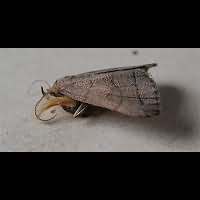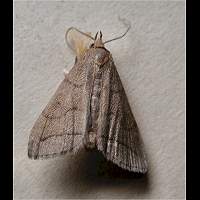Fan-foot Zanclognatha tarsipennalis
The Fan-foot is just one of the many Fan-feet and Snouts. And all Fan-feet and Snouts are weird creatures, for they are rather small and don't look like Owlet Moths at all. The snout seems to suggest a Snout Moth. The broad wings, which are kept parallel seem to point out one of the Geometer Moths, though. All Fan-feet and allies are rather similar. Why they are called Fan-feet in common English can be seen in the top picture: the leg has been provided with a big fan! The easiest way of telling the members of this group apart is by looking at the lines in the wings, of which there are usually three. In case of the Fan-foot the upper line has a small dench in the beginning, but then runs straight. The middle line winds at the start, followed by a very faint curve. The lower line is bold, but runs almost straight from one edge of the wing to the other. The Jubilee Fan-foot has a small but clear indentation in the upper line near the edge of the wing. In the middle line the winding is much stronger, but the curve is absent, or almost absent. The lower line runs much more upwards. The Shaded Fan-foot has a smear (the 'shade') between the upper and middle lines. Besides it doesn't have dots along the fringe, but a complete line. The Small Fan-foot has both the upper and the lower line bold. Besides the lower line starts in the tip of the wing. In all other Fan-feet this line starts higher up on the wing. The Clay Fan-foot has two lines only. In the other lined Fan-Feet, such as the Plumed Fan-foot, the Dusky Fan-foot, the Common Fan-foot and the Olive Crescent the lower line is yellow, not dark brown. The wing span of the Fan-foot is some 30 to 35mm.
The eggs are being laid from June. After hatching the larvae feed on withered and fallen leaves of the food plants. In autumn they spin a cocoon among the leaf litter in which the caterpillar overwinters. In spring without ever leaving the cocoon they pupate. The caterpillars are brown or greyish brown and have a very faint dorsal line. More striking are the spiracula, which are black surrounded by a light circle. The head is dark brown with lighter markings. The caterpillars grow to a length of 17 to 20mm only. They feed on the withered leaves of beech, oak and bramble.
The Fan-foot is on the wing from June to early August. In southern parts of England also seen flying about in very small numbers from late August to October. These are probably animals of a small second generation. The animal rests in low vegetation by day, but is very easily disturbed. Starts flying in dusk and is then seen visiting flowers, including those in gardens. Comes to both light and sugar, but in small numbers only. Hard to take pictures of, for it will use every possibility to fly away. Common and widespread in Southern parts of Britain. In Central Britain, including Ireland and the southern part of Scotland a local species only, getting scarcer going northwards. Not found north of Southern Scotland.
The Fan-foot is just one of the many Fan-feet and Snouts. And all Fan-feet and Snouts are weird creatures, for they are rather small and don't look like Owlet Moths at all. The snout seems to suggest a Snout Moth. The broad wings, which are kept parallel seem to point out one of the Geometer Moths, though. All Fan-feet and allies are rather similar. Why they are called Fan-feet in common English can be seen in the top picture: the leg has been provided with a big fan! The easiest way of telling the members of this group apart is by looking at the lines in the wings, of which there are usually three. In case of the Fan-foot the upper line has a small dench in the beginning, but then runs straight. The middle line winds at the start, followed by a very faint curve. The lower line is bold, but runs almost straight from one edge of the wing to the other. The Jubilee Fan-foot has a small but clear indentation in the upper line near the edge of the wing. In the middle line the winding is much stronger, but the curve is absent, or almost absent. The lower line runs much more upwards. The Shaded Fan-foot has a smear (the 'shade') between the upper and middle lines. Besides it doesn't have dots along the fringe, but a complete line. The Small Fan-foot has both the upper and the lower line bold. Besides the lower line starts in the tip of the wing. In all other Fan-feet this line starts higher up on the wing. The Clay Fan-foot has two lines only. In the other lined Fan-Feet, such as the Plumed Fan-foot, the Dusky Fan-foot, the Common Fan-foot and the Olive Crescent the lower line is yellow, not dark brown. The wing span of the Fan-foot is some 30 to 35mm.
The eggs are being laid from June. After hatching the larvae feed on withered and fallen leaves of the food plants. In autumn they spin a cocoon among the leaf litter in which the caterpillar overwinters. In spring without ever leaving the cocoon they pupate. The caterpillars are brown or greyish brown and have a very faint dorsal line. More striking are the spiracula, which are black surrounded by a light circle. The head is dark brown with lighter markings. The caterpillars grow to a length of 17 to 20mm only. They feed on the withered leaves of beech, oak and bramble.
The Fan-foot is on the wing from June to early August. In southern parts of England also seen flying about in very small numbers from late August to October. These are probably animals of a small second generation. The animal rests in low vegetation by day, but is very easily disturbed. Starts flying in dusk and is then seen visiting flowers, including those in gardens. Comes to both light and sugar, but in small numbers only. Hard to take pictures of, for it will use every possibility to fly away. Common and widespread in Southern parts of Britain. In Central Britain, including Ireland and the southern part of Scotland a local species only, getting scarcer going northwards. Not found north of Southern Scotland.





